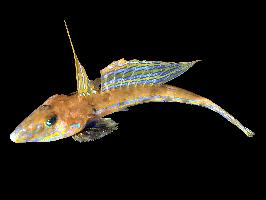
Poids et mesures
| Longueur | de 20 à 30 cm |
|---|
Description de l'animal
The Common Dragonet (Callionymus lyra) is a fascinating and unique species of fish that dwells in the sandy and muddy bottoms of shallow coastal waters, primarily found in the Eastern Atlantic from Norway and Iceland, extending south to Senegal, including the Mediterranean and the Black Sea. This species is especially noted for its distinctive appearance and interesting behavior, making it a subject of intrigue among marine biologists and aquatic enthusiasts alike.Adult Common Dragonets typically reach lengths of up to 30 centimeters (12 inches), although males are generally larger and more vividly colored than their female counterparts. The body of the Common Dragonet is elongated and somewhat flattened, an adaptation that allows it to blend seamlessly with the seabed, providing camouflage from predators and enabling it to ambush prey. The skin is smooth, lacking scales, and adorned with intricate patterns and hues ranging from sandy browns and grays to more striking blues and oranges, particularly in males. This coloration not only serves as camouflage but also plays a vital role during mating displays.
One of the most striking features of the Common Dragonet is its head, which is large in proportion to its body and characterized by a downturned mouth and large, expressive eyes that provide a wide field of vision for spotting prey and predators. The dorsal fin is another distinctive feature, especially in males, where it is elongated and ornately decorated with patterns and colors that become more pronounced during the breeding season. This fin is used in elaborate courtship displays to attract females.
The diet of the Common Dragonet primarily consists of small invertebrates such as worms, crustaceans, and mollusks, which it hunts using its keen sense of smell and ability to detect the faint vibrations of its prey moving through the sediment.
Reproduction in Common Dragonets involves a fascinating mating ritual where the male performs a dance to attract a female, displaying his brightly colored dorsal fin and engaging in a series of movements to demonstrate his fitness as a mate. After mating, the female lays eggs in the sandy or muddy substrate, where they remain until hatching. The larvae are pelagic, drifting with the currents until they are developed enough to settle on the bottom and adopt a benthic lifestyle.
In terms of habitat, the Common Dragonet prefers shallow, coastal waters with sandy or muddy bottoms where it can easily camouflage itself. It is a demersal species, spending most of its time close to or on the seabed. While not considered endangered, the Common Dragonet faces threats from habitat destruction and pollution, which can impact its breeding grounds and food sources.
In conclusion, the Common Dragonet is a remarkable example of adaptation and specialization in marine fish. Its unique physical characteristics, behavior, and life cycle make it a captivating subject for study and highlight the diversity of life found in our oceans.
Animaux similaires
Nouvelles photos d'animaux
Top 10 des animaux
- Dolphin gull (Leucophaeus scoresbii)
- Japanese macaque (Macaca fuscata)
- Stone loach (Barbatula barbatula)
- Greek tortoise (Testudo graeca)
- Russian tortoise (Testudo horsfieldii)
- Galápagos tortoise (Geochelone nigra complex)
- Diana monkey (Cercopithecus diana)
- Moustached guenon (Cercopithecus cephus)
- Common flying dragon (Draco volans)
- Galápagos penguin (Spheniscus mendiculus)
